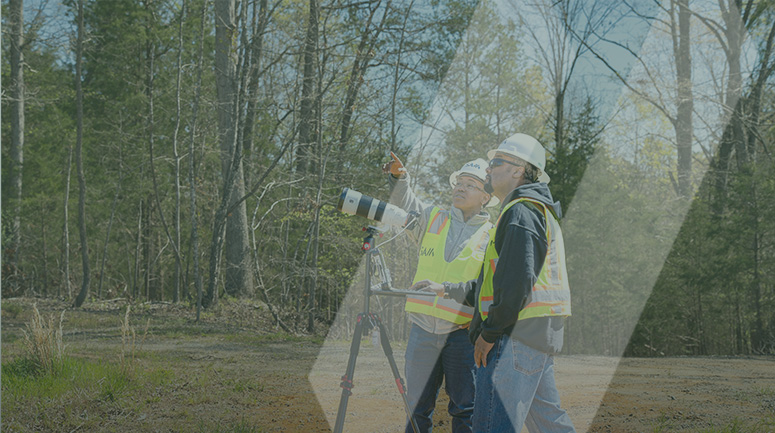A Day in the Life: Applied Science for Facility Ratings
| Bryan Fitzpatrick

Recently, Monica Vegas was measuring the sizes of 40 different electrical conductors at a substation in a suburban environment. She must be accurate down to less than a millimeter relative accuracy, not just for the overall conductor diameter, but for the individual strand diameter as well. Normally a person performing this task would use a set of precise digital calipers while standing in a bucket truck or hanging onto the structure itself.
But Monica isn’t using calipers to measure. She isn’t in a bucket truck, and she isn’t required to climb an energized structure.
In fact, she isn’t even inside the substation. She’s measuring these electric components approximately 250 feet outside the fence.
Monica is using SAM’s Applied Science for Facility Ratings (ASFR) technology, a patented system for using terrestrial photogrammetry to measure round objects with a precision of 0.762 millimeters, or three-hundredths of an inch. ASFR is a combination of hardware, custom software, and procedures that enable Monica and her teammates to take measurements at a safe distance from energized conductors.
To the casual observer walking by the 345kv substation, Monica Vegas looks like a peculiar combination of a construction worker and a sports photographer. Outfitted with steel-toe boots, a reflective vest, a hard hat, and fire-resistant clothing, she could pass for any number of field workers in the electric utility industry. Her equipment, however, looks more at home outside an NFL end zone: a full-frame camera with a variable zoom telephoto lens atop a lightweight carbon fiber tripod. A laser rangefinder completes the instrument setup.
“I like that this system is designed to use the least amount of equipment possible. Everything I use on the job can fit into a backpack,” Monica said. “We often walk the equipment along an alignment without a vehicle so as not to disturb the land, so this lightweight kit is essential.”
The remotely sensed imagery and measurements are inputs in a formula that determines a strand count of the outer layer, then compares the precise measurements to a database of potential conductors from a manufacturer’s catalog. We’re able to decipher all the information to inform the electric utility which code is associated with the conductor so that they can use the manufacturer’s data for their Facility ratings.
Facility ratings and the methodology behind them are required by the North American Electric Reliability Corporation (NERC) FAC 008 for the entire bulk electric system. Conductors have always been the most challenging to confirm because they don’t have data plates like a transformer or wave trap.
I have been fortunate to be part of a team of scientists consisting of Certified Photogrammetrists, Licensed Surveyors, GIS Professionals, and Software Developers to create a workflow that is rapidly being adopted to replace traditional methods of determining conductor type. Monica Vegas’ camera and lens were selected for their low distortion and high pixel resolution. The rangefinder was tested by an RPLS against two different distance-measuring devices to ensure accuracy. The automated edge detection routine she uses was developed by scientists in SAM’s Applied Technology group. All of these different technologies and methods were engineered into a process so Monica can take a picture, make a measurement, and provide a result quickly with a high degree of certainty.
This means large FAC 008 inspections and compliance can be done in months instead of years. And much more safely.
Yvonne Harding, GISP, RPLS, is the Senior Project Manager who runs the day-to-day operations of this service for SAM.
“What our clients like the most is the safety,” she said, “they don’t have direct contact with electrical components like they would with bucket trucks or climbing. We remain within the safe areas of the substation at all times because we take measurements from hundreds of feet away.”
Back on the job site, Monica finishes up her measurements for the day, including the last ones for the substation. Before she leaves the site, she’ll upload all results so they can be checked by our office staff or quality assurance and delivered to the client the next day. This way, repeat trips are minimized by eliminating the gap between data acquisition and confirmation of results.
With the results confirmed, she packs up her camera, folds the tripod, stows it all in the truck’s back seat, and heads off to the new location.
So how effective is the ability to make 20 to 50 measurements in a day? Measuring its effectiveness in dollars puts it in the millions. Measuring it in time, the efficacy of SAM’s method is calculated in years. One client scoped five years to complete their facility ratings using climbers and trucks. SAM helped them do it in 18 months, and the results passed a third-party audit. They’ve been able to reinvest the millions of dollars they saved into other engineering programs or bottom-line savings.
This is a huge source of pride for SAM, but even more important has been increased safety. It’s great that we saved our client millions of dollars and years of time. But for me, the best part is that no one fell off a tower. No bucket trucks rolled over in uneven terrain. We kept people safe. We filled a role that let the linemen focus on other areas to keep the lights on, and we helped bring people home to their families at night. That is what I find most valuable about this technology.
Learn more about how our patent-pending Applied Science for Facility Ratings on our webpage, reach out to Bryan Fitzpatrick directly, or fill the form below.
Bryan Fitzpatrick
Bryan Fitzpatrick, our Business Development Manager, with almost two decades of aviation experience, including nearly ten years at SAM, spearheads the Applied Science for Facility Ratings program. He helped lead the development of SAM’s patent-pending technology that is changing the way utilities inventory their equipment.
View Profile
